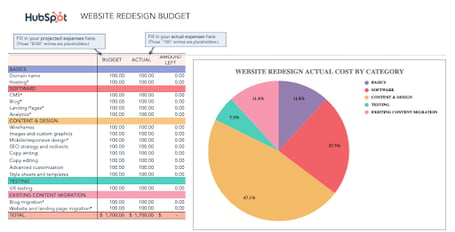THE 7 BEST MARKETING BUDGET TEMPLATES — A MUST-READ FOR B2B MARKETING MANAGERS
Written by

“Do more with less.”
If you’re like many marketing professionals in manufacturing and supply chain, you’re expected to extend your Sales team’s reach, fill their pipelines, and shorten the sales cycles. No simple tasks.
Yet, by wisely using a marketing budget template, you can reach your marketing goals, even if the numbers in that budget aren’t exactly inspiring.
With a limited marketing budget, your selected tactics must be effective and tightly aligned with Sales and, most importantly, business growth goals. It’s vital to compare where your budget is being spent against the results of the channels being used.
It’s easy to second guess tactical choices if it’s difficult to calculate ROI or if part of your marketing plan is experimental or unproven. It’s also understandable that executive stakeholders might be hesitant to commit appropriate funding for marketing strategies if you can’t demonstrate results.
After creating a marketing budget, you’ll clearly identify your goals and understand what it will cost to achieve them, as well as have a roadmap against which to measure the performance of channels and tactics in your annual marketing plan.
The Guts of a Marketing Budget
Instead of your challenges limiting your growth opportunities, use marketing budget templates and other budget planning tools to help prioritize and identify the right investments to make in various areas:
- Content creation
- Social media
- Website enhancements
- Email marketing
- Paid advertising campaigns
- Trade shows and events
- Branding and creative
- Public relations
- Lead nurturing
- And more
Then, set SMART goals to track your progress in specific, measurable, attainable, realistic, and time-bound ways. Likewise, have effective processes in place to execute a marketing plan that attracts qualified website traffic and fills the sales funnel.
How to Make a Marketing Plan: Start With the Right Marketing Budget Template
Where are you in your inbound marketing journey?
- Learning about inbound marketing as a growth strategy
- Solid knowledge and ready to start your inbound program
- An experienced marketer who wants to boost your inbound marketing results
Whatever your situation, having a template when setting a marketing budget can help you get it done efficiently and guide your annual marketing plan.
Here are the best marketing budget templates we’ve found. Consider using one or more of these as you plan.
1. SMARTSHEET
While a bit dated, these 12 ready-to-use marketing budget templates include a simple yearly budget, website budget, social media marketing budget, and sample marketing budget. These detailed and colorful marketing budget breakdowns help outline where money is being spent.
2. HUBSPOT
HubSpot offers 8 marketing budget templates to manage your overall spend and individual budgets in product marketing, content, paid advertising, public relations, branding and creative, website redesign, and events.
HubSpot provides detailed instructions for users, and each template includes interactive charts that auto-populate based on the numbers entered on the worksheets. There are columns for both projected costs and actual figures, so you can track your progress throughout the year.
3. DEMAND METRIC
Specifically designed for a content marketing budget, this template helps you track your progress with standardized views such as actual vs. budget, spend on marketing summary, and category breakdown. A separate marketing budget tool expands to monitor all marketing plan expenses beyond content.
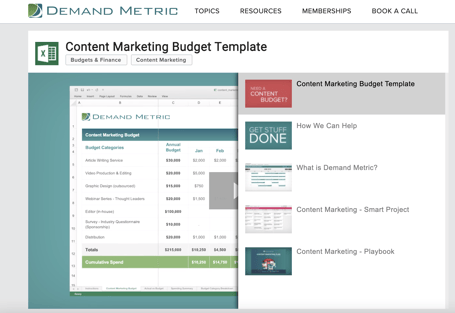
RELATED: HOW MUCH SHOULD YOU BUDGET FOR CONTENT CREATION IN YOUR ANNUAL MARKETING PLAN?
4. PROJECTMANAGER
This marketing budget template for Excel is built to help launch a campaign and keep it on target. A simple, strategic tool, it helps structure your budget so you can monitor and spend effectively across all your marketing channels.

5. SCORE
A simple spreadsheet helps you outline your annual marketing budget, breaking it up into quarters and providing recommended itemized lists for marketing expenses. Sections include brand development, public relations, advertising, website development, market research, sales, events, and travel.
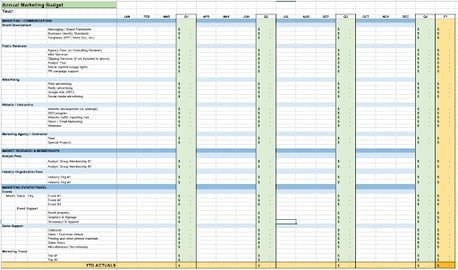 YOU MIGHT ALSO LIKE: 7 ELEMENTS EVERY QUARTERLY MARKETING ROADMAP NEEDS
YOU MIGHT ALSO LIKE: 7 ELEMENTS EVERY QUARTERLY MARKETING ROADMAP NEEDS
6. VITAL
This template lists categories and calculates your balance each month in addition to your overall annual budget. Helpful and color-coded, it uses placeholders with figures based on a hypothetical budget. Simply replace them with your own numbers, and you’re off and running.
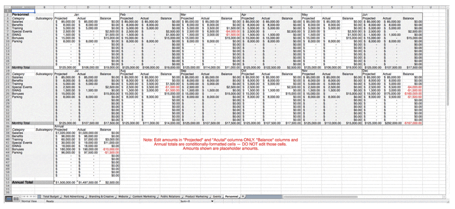
7. GANTTPRO
Choose your marketing budget template (Google Sheets, Excel) or a Gantt chart and then begin to manage your marketing projects. Another option is using the professional, ready-made GanttPro software, allowing you to customize to your needs.
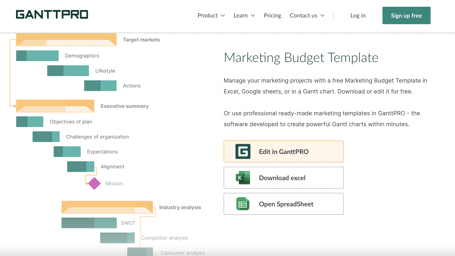
Align Your Marketing Budget Plan With Business Objectives
In some companies, marketing is seen as a cost center. In order for your marketing to be seen as an investment, like the R&D team, you need to ensure your marketing budget aligns with corporate objectives.
Establishing your goals, marketing plan, and budget around your organization’s sales funnel — and knowing your true operational costs — are ways to ensure you’re in alignment with business growth objectives.
RELATED: How to Create a Marketing Plan: Follow These 5 Steps
Once you’re in alignment and your budget is approved, be sure to implement a regular reporting cadence using your marketing budget tool of choice. If you’re using a marketing automation system, such as HubSpot as your website CMS and your CRM, you can easily track and report marketing ROI from a single system.
Also think about the format of your reports to leadership — you must speak the language of those authorizing the overall cost of your annual marketing plan, not only in the budgeting stage but throughout the year.
Decision makers may not immediately see the connection between how expanding your knowledge base or increasing content development impacts the number of opportunities and closed deals. But, showing how those tactics positively impact sales revenue in a clear and concise manner fosters continued support of your inbound marketing initiatives.
Need insights on creating an annual marketing plan? Look no further than our Annual Marketing Plan Resources page; it’s loaded with helpful tips and tools.
Subscribe To Our Blog
Information. Insights. Ideas. Get notified every time a new Weidert Group blog article is published – subscribe now!
You May Also Like...

Search Engine Optimization
Optimize Your Industrial Website for AI Search

Marketing Technology
Why Unified Data Efforts Fail (and How Manufacturers Can Fix It)

Search Engine Optimization
How Falcon Rebuilt Industrial AI Search Visibility in 2025
Accelerate Your Growth with
Weidert Group
If you’re ready to explore a partnership, request a personalized consultation with our team.
